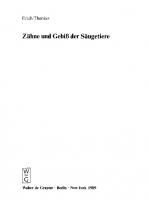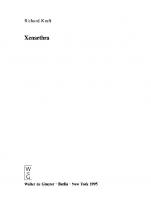Handbook of Zoology / Handbuch der Zoologie: Teilband/Part 35 Volume 1: Evolution, Systematics, and Biogeography 9783110804744, 9783110157048
140 114 42MB
English Pages 501 [504] Year 1998
Editor’s preface
Contributors
1. Historical Introduction
2. Phylogeny and Palaeontology
3. Classification and Keys to Higher Taxa
4. The Non-Glossatan Moths
5. The Homoneurous Glossata
6. The Monotrysian Heteroneura
7. The Tineoidea and Gracillarioidea
8. The Yponomeutoidea
9. The Gelechioidea
10. The Zygaenoidea
11. The Cossoid/Sesioid Assemblage
12. The Tortricoidea
13. The Smaller Microlepidopteran-Grade Superfamilies
14. The Pyraloidea
15. The Axioidea and Calliduloidea
16. The Butterflies: Hedyloidea, Hesperioidea and Papilionoidea
17. The Drepanoid/Geometroid. Assemblage
18. The Bombycoidea and their Relatives
19. The Noctuoidea
20. Evolution of Larval Food Preferences in Lepidoptera
21. Biogeography of the Lepidoptera
Index of Scientific Lepidoptera Names
Recommend Papers

File loading please wait...
Citation preview
Handbuch der Zoologie Handbook of Zoology Band/Volume IV Arthropoda: Insecta Niels P. Kristensen (ed.) Lepidoptera, Moths and Butterflies Volume 1: Evolution, Systematics, and Biogeography Teilband/Part 35
Handbuch der Zoologìe Eine Naturgeschichte der Stämme des Tierreiches
Handbook of Zoology A Natural History of the Phyla of the Animal Kingdom
Gegründet von / Founded by Willy Kükenthal Fortgeführt von / Continued by M. Beier, M. Fischer, J.-G. Helmcke, D. Starck, H. Wermuth
Band / Volume IV Arthropoda: Insecta Herausgeber / Editor
W DE G
Teilband / Part 35
Maximilian Fischer
Walter de Gruyter · Berlin · New York 1999
Niels P. Kristensen (ed.)
Lepidoptera, Moths and Butterflies Volume 1: Evolution, Systematics, and Biogeography
W DE G Walter de Gruyter · Berlin · New York 1999
Autor und Herausgeber Author and Scientific Editor
Schriftleiter und Herausgeber Managing and Scientific Editor
Professor Dr. Niels P. Kristensen Zoological Museum University of Copenhagen Universitetsparken 15 DK-2100 Copenhagen Denmark
Hofrat Univ.-Doz. Mag. Dr. Maximilian Fischer Direktor am Naturhistorischen Museum Wien Burgring 7 A-1014 Wien Austria
Verlag / Publishers Walter de Gruyter GmbH & Co. Genthiner Straße 13 D-10785 Berlin Germany
Walter de Gruyter, Inc. 200 Saw Mill River Road Hawthorne, N. Y. 10532 USA
Library of Congress - Cataloging-in-Publication
Data
Handbook of Zoology agr 2 3 - 1 4 3 6
Die Deutsche Bibliothek - Cataloging-in-Publication
Data
Handbuch der Zoologie : eine Naturgeschichte der Stämme des Tierreiches / gegr. von Willy Kükenthal. Fortgef. von M. Beier ... — Berlin ; New York : de Gruyter Teilw. mit Paralleli.: Handbook of zoology Bd. 4. Arthropoda: Insecta / Hrsg. Maximilian Fischer Teilbd. 35. Lepidoptera, moths and butterflies Vol. 1. Evolution, systematics, and biogeography / Niels P. Kristensen (ed.). - 1998 ISBN 3-11-015704-7
© Printed on acid-free paper which falls within the guidelines of the ANSI to ensure permanence and durability.
Copyright © 1998 by Walter de Gruyter GmbH & Co., Berlin. All rights reserved, including those of translation into foreign languages. No part of this book may be reproduced in any form - by photoprint, microfilm or any other means nor transmitted nor translated into a machine language without written permission from the publisher. - Printed in Germany. Typesetting and Printing: Arthur Collignon GmbH, Berlin. - Binding: Lüderitz & Bauer G m b H , Berlin.
Editor's preface
Thirty years have elapsed since the publication of the first issues in this second edition of the Insecta section of the Handbuch der Zoologie! Handbook of Zoology. Not surprisingly therefore, editorial principles and standards are now changing to ensure that the series can continue to fulfill its intended role in the biological reference literature. While treatments of the majority of the small and mediumsized insect groups conventionally ranked as 'orders' have been issued already, only a single treatment of a 'megadiverse' order has been completed, viz., Willi Hennig's 1973 volume on the Dipera. By the 1980s it had become clear that accounts of the larger insect groups of the breadth and depth required in the Handbuch/ Handbook series were far beyond the capacity of any single author or even of a small team of authors. The present Lepidoptera volume, then, is the first example of the genuine multi-author treatment which will be adopted in forthcoming volumes on the large insect orders. Moreover, it is our aim that future volumes in the series focussing on systematic entities will be published in English. Two Lepidoptera volumes are planned. The present volume on systematics, evolution and biogeography will be followed by one on morphology and physiology. The latter is in an advanced stage of preparation. Plans for a third volume dealing with Lepidoptera ecology and behaviour were abandoned after consultation with a number of potential editors: While ecological and behavioural research on moths and butterflies has long been vigorous, there is greater motivation for reviewing findings emerging therefrom in contexts other than one centred just on the order Lepidoptera. Needless to say, a certain body of information on ecology and behaviour is indeed being provided in relevant places in both volume 1 and 2. Moreover, volume 1 was broadened to accommodate a chapter on larval food relationships, a topic which certainly can be appropriately summarized in a Lepidoptera context, i.e., within a large-scale evolutionary framework. Cross references between chapters in this twovolume Handbook treatment of the Lepidoptera is eased by means of emboldened volume-andchapter numbers; thus 1 - 8 and 2—8 refer to chapter 8 in volume 1 and 2 respectively. Name sequence of contributors to coauthored chapters is alphabetical (except in the case of chapter 1—20, where this principle was abandoned at an express request from within the author team), hence it does not necessarily indicate who was the principal contributor (if the workload was indeed unevenly shared). How-
ever, in the case of some chapters where the responsibility for different section has been clearly divided between authors, this has been explained. As is usual in works of this kind an approximate total length of the volumes was agreed from the outset. The subsequent page allocation to individual chapters was evidently fraught with problems. As far as the systematics chapters are concerned a balance was sought between criteria concerning species richness, diversity (there is not necessarily a simple correlation of the two), importance in a phylogenetic context, biological phenomena of general interest, and knowledge available. Unquestionably different traditions in the study of different major lineages, as well as contrasting maturity of their classifications, contribute to any imbalance that may remain in the treatment. For instance, while all tortricoid moths are included currently in just a single family, a globally applicable tribal taxonomy is now available for this lineage; the detailed treatment down to this level is likely to be welcomed by users. By contrast, the preliminary state of the higher classification of the much more speciesrich family Geometridae largely explains the relatively more brief treatment of this taxon. Since most authors probably considered alloted space inadequate for a proper treatment of their subjects), exesses were the rule rather than the exception! Some manuscripts were shortened by the editor. But variation between authors in observing space limitations remains another source of imbalance in chapter length. Differences between individual chapters in style and presentation have been left unharmonized, as long as they are unlikely to create confusion. For instance, the use of both Roman and Arabic numerals to designate abdominal segment numbers has been accepted. Similarly, examples of both English and American spelling will be found. While works of this kind are intended primarily to provide state-of-the-art reviews, the preparation of contributions for the present volume prompted some authors to undertake a substantial amount of original research. Hence the content of some chapters is truly innovative. Necessarily, subjective decisions had to be made concerning what could appropriately be included in the treatment published here. For instance, the sizable original analyses of butterfly inter-relationships upon which chapter 1 — 16 is largely based were found to exceed the scope of a Handbook chapter, and they were accordingly published as a separate journal article (de Jong, R., Vane-Wright, R. I. & Ackery, R R.: Ent. scand.
VI 27: 6 5 - 1 0 1 , 1996). But it was decided that the similarly innovative analysis of Gelechioid phylogeny, which forms the basis of 1—9, should be included, with the primary material printed as appendices. While some contributions were completed just before type-setting of the entire colume was initiated, others had been completed considerably earlier. However, most authors were able to take the opportunity to make additions to their contributions in 1997, so the volume as a whole will appear reasonably updated by the time of its publication.
Editor's preface
As an editor I am greatly indebted to the team of authors for their commitment, faith and patience. I similarly thank the numerous specialists who provided reviews of individual chapters. Finally I thank D r Maximilian Fischer (former sole editor, Insecta section of the Handbook series) as well as P D Dr Mario Noyer-Weidner and Ms Christiane Bowinkelmann (Walter de Gruyter, Biosciences Division) and Ms Ingeborg Klak (Walter de Gruyter, Production Department) for their collaboration on this enterprise. Copenhagen, April 1998 Niels P. Kristensen
Contents
Editor's preface Contributors 1. Historical Introduction. Niels P. Kristensen 2. Phylogeny and Palaeontology. Niels P. Kristensen & Andrzej W. Skalski 3. Classification and Keys to Higher Taxa. David J. Carter & Niels P. Kristensen. . 4. The Non-Glossatan Moths. Niels P. Kristensen
V IX 1 1 27 41
5. The Homoneurous Glossata. Niels P. Kristensen
51
6. The Monotrysian Heteroneura. Donald R. Davis
65
7. The Tineoidea and Gracillarioidea. Donald R. Davis & Gaden S. Robinson
91
8. The Yponomeutoidea. John S. Dugdale, Niels P. Kristensen, Gaden S. Robinson & Malcolm J. Scoble 119 9. The Gelechioidea. Ronald W. Hodges
131
10. The Zygaenoidea. Marc E. Epstein, Henk Geertsema, Clas M. Naumann & Gerhard M. Tarmann 159 11. The Cossoid/Sesioid Assemblage. Edward D. Edwards, Patricia Gentili, Niels P. Kristensen, Marianne Horak & Ebbe S. Nielsen 181
12. The Tortricoidea. Marianne Horak
199
13. The Smaller Microlepidopteran-Grade Superfamilies. John S. Dugdale, Niels P. Kristensen, Gaden S. Robinson & Malcolm J. Scoble 217 14. The Pyraloidea. Eugene Munroe & M. Alma Solis . . . .
233
15. The Axioidea and Calliduloidea. Joël Minet
257
16. The Butterflies: Hedyloidea, Hesperioidea and Papilionoidea. Phillip R. Ackery, Rienk de Jong & Richard I. Vane- Wright 263 17. The Drepanoid/Geometroid Assemblage. Joël Minet & Malcolm J. Scoble
301
18. The Bombycoidea and their Relatives. Claude Lemaire & Joël Minet 321 19. The Noctuoidea. Ian J. Kitching & John E. Rawlins
. . . 355
20. Evolution of Larval Food Preferences in Lepidoptera. Jerry Powell, Charles Mitter & Brian Farrell 403 21. Biogeography of the Lepidoptera. Jeremy D. Holloway
![Handbook of Zoology / Handbuch der Zoologie: Teilband/Part 60 [Volume 1:] Systematics [Reprint 2020 ed.]
9783110888157, 9783110140811](https://ebin.pub/img/200x200/handbook-of-zoology-handbuch-der-zoologie-teilband-part-60-volume-1-systematics-reprint-2020nbsped-9783110888157-9783110140811.jpg)








![Handbook of Zoology / Handbuch der Zoologie: Tlbd/Part 34 Dictionary of Insect Morphology [Reprint 2012 ed.]
9783110816471, 9783110148985](https://ebin.pub/img/200x200/handbook-of-zoology-handbuch-der-zoologie-tlbd-part-34-dictionary-of-insect-morphology-reprint-2012nbsped-9783110816471-9783110148985.jpg)